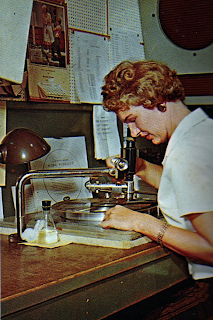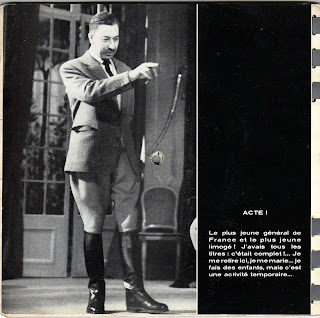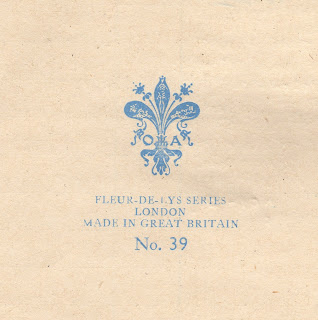The following booklet was part of a large educational series put out by Doubleday in the late 50s through the 60s. I guess they were distributed through schools, though I'm not really sure about this. There's not much info on these on the web.

These booklets covered a wide variety of topics, but our focus here is "Music and Electronics", published in 1967. The book is full of great illustrations, starting with this terrific front cover. Man, I hope the original isn't mouldering in some landfill. I'd hang it in my living room. Anyway, the book explains the first principles of sound/hearing, sound technology, recording technology etc. On it's own merits, it's a great 'for dummies' -style overview of these concepts.

A distinguishing feature for this book series was that they came with a bunch of stickers that you'd tear out and place in designated spots in the booklet. The cool thing about this particular booklet is that the sticker set focused on the end-to-end process of record-making! The copy I found had all the stickers intact and still stapled in their original spot in the middle of the book. Unfortunately, time caused the gum on the sticker backs to fuse them all together. With the help of my photoshop-savvy son, we've managed to scan and crop these images to give you a tour of record manufacturing, Capitol records-style.
You may note that although the publishing date is 1967, this photo set seems considerably older, maybe late-50s, early 60s. You may also note that the captions that went along with these photos, which I include here, are also very much of the same era.

Above is a labeling sticker. These books came with storage cases that held four apiece. You'd put these stickers on the front of the box, and the smaller label below on the spine. Right, on with it!

"Recording the Music - The first step in the making of a record: playing the music. Robert Irving conducts a performance of
The Seasons by Alexander Glazounov for Capitol Records. This photograph was taken during a recording session at Manhattan Center in New York."
I love the casualness of these photos. This one manages to instantly demythologize the music-making part of it as a simple step one. The coats flung over the chairs in the background are great.

"Preparing the Master Tape - After a musical work has been recorded and edited, it must be 'mastered', the crucial step of transferring from tape to disc. Here an audio engineer adjusts the level control before cutting an acetate disc. This process requires extreme skill since, no matter how good the master tape, a finished record can never be better than the disc."
And no tie required.

"Cutting the Acetate - Standing in front of his Scully lathe cutter, the audio engineer examines the grooves in an acetate disc he is cutting. He is looking for correct groove formation, correct depth and sufficient groove separation."

"Raw Vinyl Powder - At the record company's pressing plant, raw materials are poured into a hopper before being mixed, heated and formed into thin, black rectangular 'biscuits' of vinyl that will later be pressed and emerge as phonograph records."

"Silvering the Acetate - At the record factory the acetate disc is given a thin coating of silver. Later, this silver coating is backed up by nickel and copper and will be peeled away to become the 'master.' Only one side of an acetate is cut; therefore there are two masters for each average record."

"Nickel and Copper Plating - When the acetate disc has been silvered, it is then dipped first into a nickel tank and then into a copper tank in order to build up its thickness."

"The Plating Process - Wearing rubber gloves and apron, a technician lifts a 'mother' from its copper plating tank. When the master was separated from the original acetate disc, it was then used to make the mother, which can be played for test purposes. The master cannot be played, since it has ridges instead of grooves."

"Checking the Mother - Quality control is of utmost importance in the manufacture of a record. Here a metal mother is played to verify that is is faultless. If the girl detects a flaw, a new mother will be made from the master."
Hmmm, Metal Mothers, where have I heard that before?

"Pressing a Vinyl Biscuit With Two Samples - Pressing room foreman operates Capitol Records' newest press. Stampers, made from the mothers, are locked in place, labels are fitted, and a heated vinyl biscuit is ready to be pressed. It will emerge a twelve-inch long-playing disc."

"Checking Production Flow - One of the production nerve centers at Capitol Records' pressing plant in Scranton, Pennsylvania, is shown here. Master charts are kept of the work flow as well as all the current record labels."

"Testing a New Pressing - If you buy a record that has bad pops and scratches on it, you return it to the dealer. He in turn returns it to the manufacturer. This does not happen very often because of the constant testing and checking of the product. Here a girl listens to a pressing selected at random. If there is a fault, then the stamper is replaced and all records made from it since the last audio check are scrapped."
My historical dream job.

"Inspection and Anti-Static Wiping - Each new record is wiped with an antistatic cloth and inserted in its jacket. Once again every single record is examined for possible flaws. All record companies, large and small, pride themselves on their quality control. In the large majority of instances the quality of the record far surpasses the quality of the machine on which it is played."
Ouch.

"Records In Inner Sleeves Inserted In Jackets - Records which have already been placed inside protective inner sleeves are inspected once more and then placed in their eye-catching jackets."

"Sealed In Clear Plastic Film - This is the final step in the manufacture of a record at the Capitol pressing plant. The record, in its jacket, is being wrapped and sealed in clear plastic film."















































